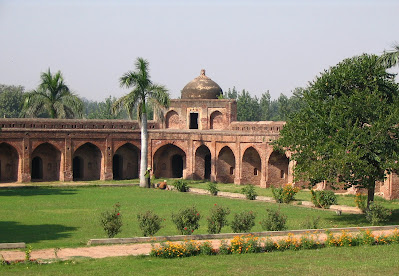 |
| Emperor Jahangir's serai at Shambhu |
Shambhu, a mere toll point on the Ambala-Amritsar stretch of NH44, is suddenly famous. First, cops blocked the border here to stop farmers from marching on Delhi. Then, the anticipated clash between farmers and police happened, and a place that thousands whizz past daily without a thought became a dateline.
But Shambhu has watched travellers come and go for at least 500 years. It lay on Sher Shah Suri’s highway five centuries ago. About 400 years ago – the exact date is not known – Emperor Jahangir built a Mughal serai here, and it’s still standing. If you’re driving from Ambala towards Amritsar, look out for a fort-like building on your right shortly after paying toll at Shambhu and crossing the Ghaggar.
Intact After 400 Years
Oddly, there’s no inscription on the serai to fix its date of construction, but art historian Subhash Parihar dated it to Jahangir’s reign – “first quarter of the 17th century” – based on certain design similarities between it and the more famous Nurmahal serai near Jalandhar.
It’s a large serai, 121m long and 101m wide, with gateways that rise to a height of 11.2m. There are dozens of cells for travellers, and a mosque in the middle of the lawns. From the long roof over the cells, you can see and hear the traffic on the highway.
A Curious Name
Shambhu is a curious name for a Mughal outpost, but in his paper, ‘Mughal Sarai at Shambhu’, Parihar points out this name does not appear in “any mediaeval chronicle or account of travel”. What did the Mughals call it then?
Parihar says there’s mention of a ‘sarai Nun’ 4 kos (10km) from Ambala. Shambhu serai is 11km from Ambala, so they must be the same. But why would it be called ‘nun’, which means ‘fish’? “The river Ghaggar flows nearby. Perhaps, ample supply of fish was available here.”
However, the name Shambhu is also old. Parihar says, in the mid-1700s French missionary Tieffenthaler mentioned a serai ‘built by Nilkanth’ as the next stage on the road after Ambala. As Nilkanth is another name for Shiva/Shambhu, Parihar thinks an old Shiva temple might have stood nearby, lending its name to the area.
Maratha-Sikh Battle
So, the Shambhu serai is not just a pile of stones and bricks. Emperors, traders, soldiers, invaders and other travellers stayed in it as they moved between Delhi/Agra and Lahore or Kashmir. It was a permanent village with a changing population.
Sometimes, battles were fought around it, as happened in 1794 when a large Maratha army demanded Patiala’s submission. The Sikhs led by Bibi Sahib Kaur were outnumbered, but they made a surprise night attack at the Maratha camp in Mardan Pur, south of Shambhu, and forced them to clear out.
***
 |
| Serai gate from outside |
 |
| Serai gate from inside |
 |
| Mosque inside serai |
 |
| Cells for travellers |



